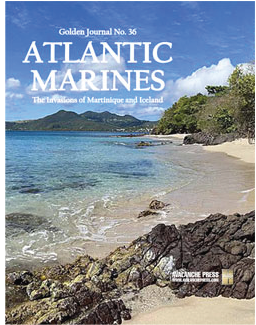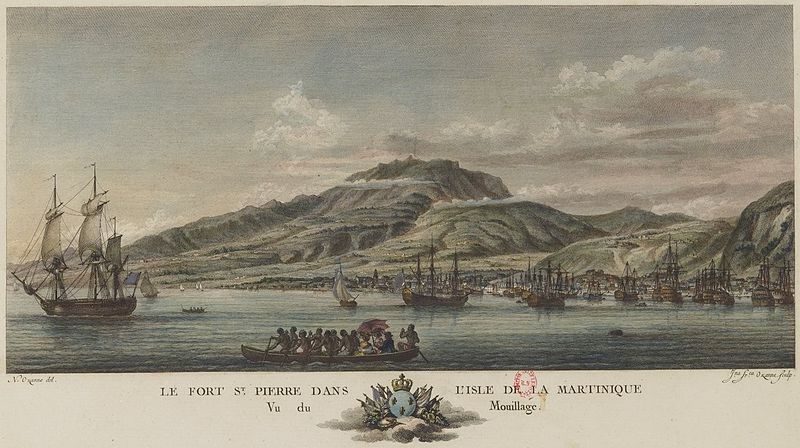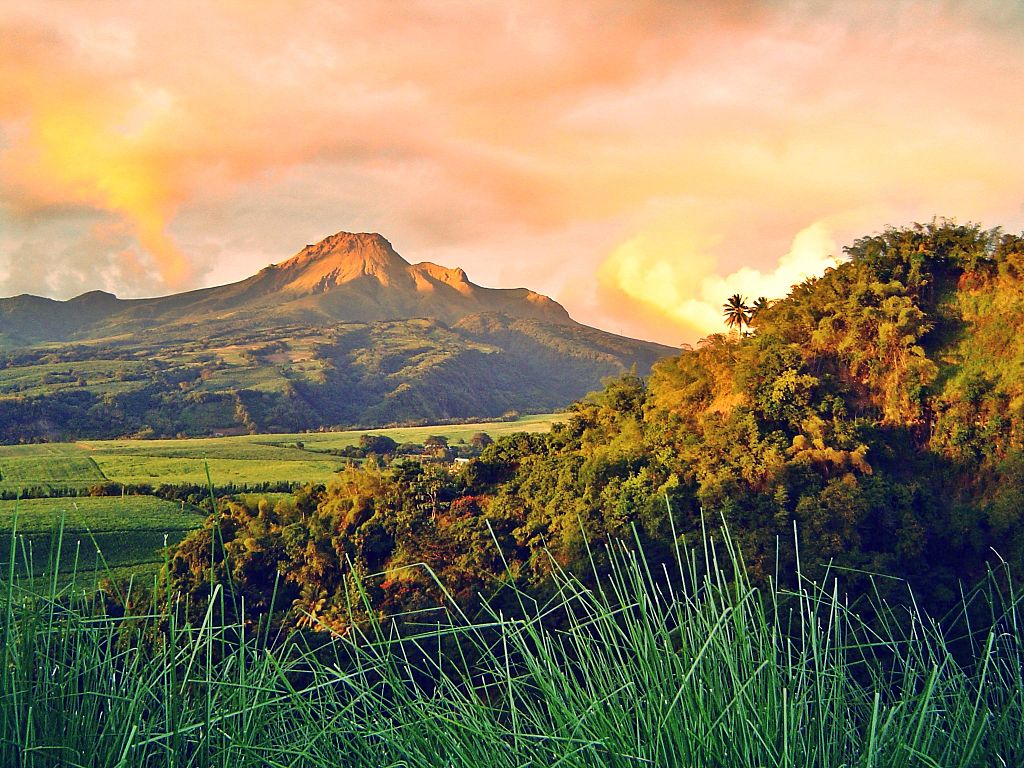| Golden Journal No. 36
(Atlantic Marines):
Martinique, Part One
by Mike Bennighof, Ph.D.
January 2021
 Martinique is a large island in the Lesser Antilles along the western edge of the Caribbean Sea, south of Dominica and north of Saint Lucia. With some interruptions by British conquest, it’s been ruled from France since its fist European settlement, and today forms an integral department of France (and thereby of the European Union). Its capital, Fort de France, lies on a large, well-protected harbor capable of sheltering mighty fleets. Martinique is a large island in the Lesser Antilles along the western edge of the Caribbean Sea, south of Dominica and north of Saint Lucia. With some interruptions by British conquest, it’s been ruled from France since its fist European settlement, and today forms an integral department of France (and thereby of the European Union). Its capital, Fort de France, lies on a large, well-protected harbor capable of sheltering mighty fleets.
French rule came to Martinique in 1635, at first in the hands of a private company before passing to the royal government in 1658. While the island had been charted by Christopher Columbus in 1493 and visited briefly by his expedition in 1502, European colonizers showed little interest in what the Carib natives called Mariana, the “Island of Flowers.”

Saint-Pierre, Martinique with volcano Mont Pelee, seen in 1776.
That changed in 1640, when sugar cane arrived on Martinique. Fourteen years later, a group of 250 Dutch Jews expelled from Brazil reached the island and began to lay out sugar plantations. The crop thrived in Martinique’s rich volcanic soil and well-watered tropical climate, and soon Martinique exported sugar alongside the rum and molasses made from it.
By 1660, in search of more sugar lands, the French settlers had exterminated or ejected the native population and imported African slaves to work the labor-intensive sugar crop. The value of exports soared, growing even faster after the introduction of coffee in 1723. All of that value came from the island’s burgeoning slave population, which resorted to regular but ineffective revolts against the system.
The British overran the island several times between the Seven Years’ War and the Napoleonic Wars, each time handing it back to the French in the peace settlements ending the various conflicts. The British had little impact on Martinique, preferring to keep the sugar plantations and rum distilleries pumping out their sweet revenues.
After some brief periods of nominal freedom under the Revolutionary governments, Martinique’s slaves finally escaped their servile status in 1848. Martinique remained a colony, but in 1871 under the Third Republic the island and other colonies gained representation in the National Assembly. A volcanic eruption in 1902 destroyed the capital, Saint Pierre, killing 30,000 people and sparing only one man protected by the thick walls of his jail cell.

Another view of Mont Pelee amid the cane fields of Martinique.
In 1913 France extended conscription to the island. Over 18,000 men were called to the colors, and 1,306 were killed. Martiniquais continued to be drafted and serve following the war’s end, and in September 1939 and January 1940 2,051 were sent to Bordeaux by way of Halifax, out of a potential 5,300 trained men. The first shipment went to infantry units, the second shipload to artillery formations. These men, along with several hundred already in France for training, served in several units raised in the XVII Military Region including the 35th Infantry Division and at least one alpine unit.
In Martinique, the remaining troops for the Bataillon d’Infanterie Coloniale de la Martinique and the Groupe d’Artillerie Coloniale de la Martinique with two field and four coastal batteries. When France reached an Armistice with the Germans in June 1940, the infantry battalion and artillery group remained in service as the island’s garrison under its Vichy-aligned governor, Admiral Georges Robert. Robert, the French High Commissioner for the West Indies and commander of French forces in the West Indies, also had a number of French warships available at Martinique: the aged aircraft carrier Béarn, the modern light cruiser Émile Bertin, the training cruiser Jeanne d’Arc and two auxiliary cruisers.
The local legislature, the General Council of Martinique, voted to fight on alongside the Allies, but Robert overruled them and aligned the garrison and naval squadron with the newly-established regime in Vichy. On paper, Robert had some significant resources to mount a defense of Martinique against an Allied assault: the additional trained manpower not sent to France before the French Army collapsed, and thousands more untrained men who might have been mobilized. The carrier Béarn had arrived with either 106 or 107 new fighter planes, Brewster Buffaloes and Curtiss Hawks purchased by the French government but not yet delivered when resistance collapsed. The cruiser Émile Bertin had escaped Halifax before the local Canadian authorities could seize her, bringing 286 tons of gold from the Bank of France that had been sent to Canada for safe-keeping for the duration of the war.

The aged aircraft carrier Béarn.
American assessments of Robert’s forces consistently overstated Martinique’s capabilities, taking those resources at face value. While he did have over 100 modern fighter planes at his disposal, all remained in their shipping crates and he had no experienced mechanics capable of assembling them. Had the aircraft somehow been put together, he had no pilots to fly them. And as they lay aboard the carrier, their canvas skins rapidly deteriorated in the warm tropical damp.
American estimates put the garrison at 8,000 to 12,000 men, counting the crews of all the warships plus the unorganized Martiniquais manpower, both reservists and untrained potential recruits. But few weapons existed to arm these men - only the small number of small arms in the lockers of the makeshift squadron and whatever anti-aircraft weapons that could be yanked off the ships and deployed ashore - and the gold that could have purchased more weaponry was of little use with no one willing or able to sell them and deliver them to Martinique. The sailors lacked infantry training, and the thousands of untrained men obviously had even less preparation for warfare. The coastal batteries were old; one of the two field batteries had 75mm Model 1897 field guns and the other 65mm mountain guns.
Even so, the Americans - still neutral, but definitely aligned against the Axis - took the French forces at Martinique very seriously. In August they negotiated an agreement with Robert, under which he undertook not to deploy his naval forces against the British in any capacity nor to allow Axis warships access to Martinique. In exchange, the Americans agreed not to invade Martinique.
Even before signing off on the secret agreement with Admiral Robert, the White House ordered the U.S. Navy to prepare plans for an invasion of Martinique.
You can carry out that invasion in Golden Journal No. 36: Atlantic Marines.
Click here to join the Gold Club.
See your Gold Club Insider newsletter for ordering information.
Sign up for our newsletter right here. Your info will never be sold or transferred; we'll just use it to update you on new games and new offers.
Mike Bennighof is president of Avalanche Press and holds a doctorate in history from Emory University. A Fulbright Scholar and NASA Journalist in Space finalist, he has published zillions of books, games and articles on historical subjects.
He lives in Birmingham, Alabama with his wife, three children, and his dog Leopold, who is a good dog.
Want to keep Daily Content free of third-party ads? You can send us some love (and cash) through this link right here.
|
